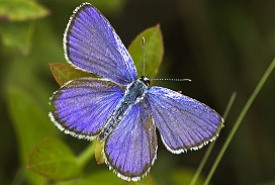
Karner blue male (Photo by www.anorchardaway.com)
Karner blue
Each summer, Conservation Volunteers travel to Alderville First Nation in southeastern Ontario with a special mission: to plant wild lupine — the species that holds the key to the future reintroduction of the Karner blue butterfly in the province.
They come to work alongside Todd Farrell, conservation biologist for the Nature Conservancy of Canada (NCC). While Farrell has been lucky enough to see the elusive Karner blue, he had to travel to Ohio to do so. Few people have ever caught a glimpse of this rare species.
Identification and life cycle
With a wingspan of about 25 millimetres, this tiny iridescent blue (male) or greyish brown (female) butterfly is hard to spot among the blossoms it feeds on. Karner blue larvae hatch from their eggs in April, enter their cocoons in mid-May and emerge as adult butterflies in early June. The adults then mate and lay their eggs on wild lupine (aka sundial lupine); the only source of food for the emerging larvae.
Amazingly, the Karner blue only spends about five days as an adult.
Where does it live?
Once, this short-ranging butterfly could be found in tall grass prairies and oak savannahs spreading across the southern Great Lakes region.
What is its conservation status?
Now it is extirpated (locally extinct) from most of its range and endangered in a few remaining pockets in the United States.
Habitat loss, specifically loss of wild lupine, its key food source, can be blamed for the butterfly's decline. Fire suppression, extensive planting of pine trees and development have caused a significant decline in prairie and savannah species.
What is NCC doing to protect habitat for this species?
NCC, Alderville First Nation, local conservation groups and landowners have teamed up in the Rice Lake Plains Joint Initiative to steward one of Ontario's last remaining areas of tallgrass prairie and black oak savannah habitat.
Located north of Cobourg, the Rice Lake Plains are home to a variety of rare species, which once included the Karner blue. The aim of the Joint Initiative is to restore this globally rare habitat by removing invasive alien species, conducting prescribed burns and re-establishing native species such as wild lupine.
NCC is also helping to restore Karner blue habitat in other parts of Southern Ontario. Through the efforts of NCC and its partners and the dedication of Conservation Volunteers, the Karner blue butterfly may one day return to Southern Ontario and we will be able to see this beautiful species in the wild once more.




